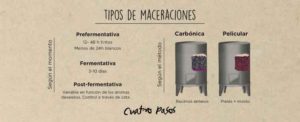Types of maceration
- Depending on the moment
Pre-fermentative (12-48h red wines; less tan 24 h white wines)
Fermentative (3-10 days)
Post-fermentative (variable depending on the desired aromas. Controlled through tasting)
- Depending on the method
Carbonic (entire bunches)
Pellicular (skins + must)
Before talking about the different types of maceration, we need to know exactly what it is. It is done when the must makes contact with the skins and the grape pulp in a same tank, giving its aromatic and structure components, which are in the skin and the cell layers right under it, to the must, to then, provide the future wine with varietal aromas, colour and structure.
Now we can start talking about the different maceration types.
Depending on when it is done:
- Pre-fermentative maceration : also called cold maceration is one of the most common ones. It is done right after filling the tank with the grapes (the must and the solid parts) and before the beginning of the alcoholic fermentation. It allows to obtain a bigger amount of pigments as well as a bigger aromatic power, giving as a result more fruity wines with more complex aromas and a more intense color in red wines with a bigger aging capacity. It is essential to keep the temperatures low during the process, between 10 and 15 degrees approximately. This is done for a period of 12 to 48 hours for red wines and no more than 24 hours for white wines.
- Fermentative : the maceration continues during the alcoholic fermentation, covering a 3 to 10 days period, reaching the maximum extraction level for almost all of its components of interest.
- Post-fermentative : This technique starts once the alcoholic fermentation ends. During this process the wine structure tries to be amplified since the wine tannins extraction is increased too. This method has to be used with caution since it can also extract aromas and TASTES we do not want.
Depending on the method :
- Carbonic maceration : the entire grape bunches are introduced in fermentation tanks with carbonic anhydride so the fermentation starts inside the berry itself. The produced wines with this technique have an intense presence of varietal aromas with a strong fruity nature.
- Pellicular maceration : the grape skin and the must are kept in contact without starting to ferment in order to obtain a more aromatic must. It is the most common one in the pre-fermentative macerations.
#4pasosvinodeloso



